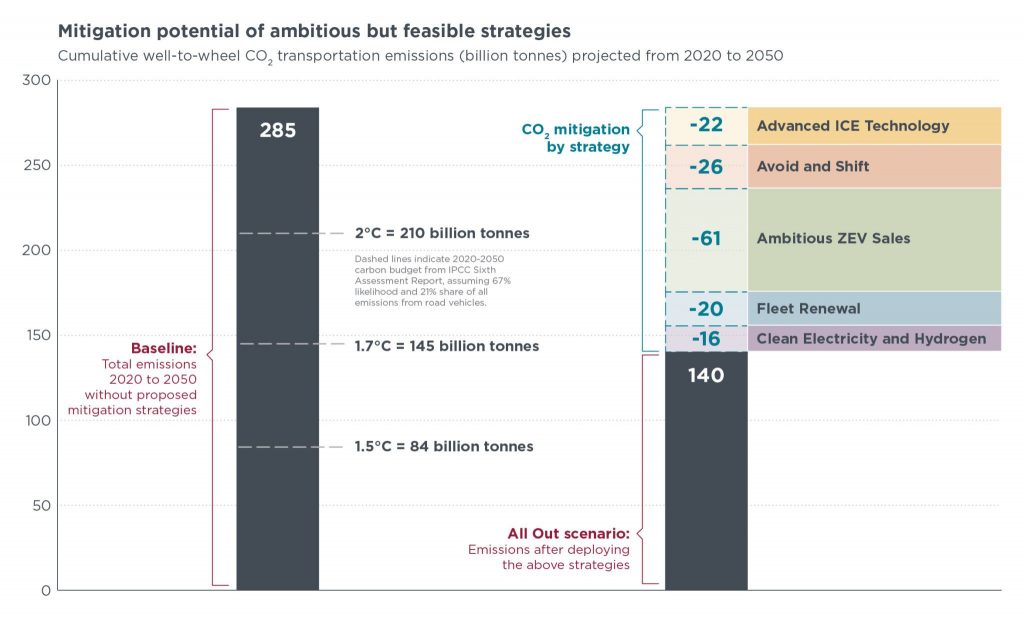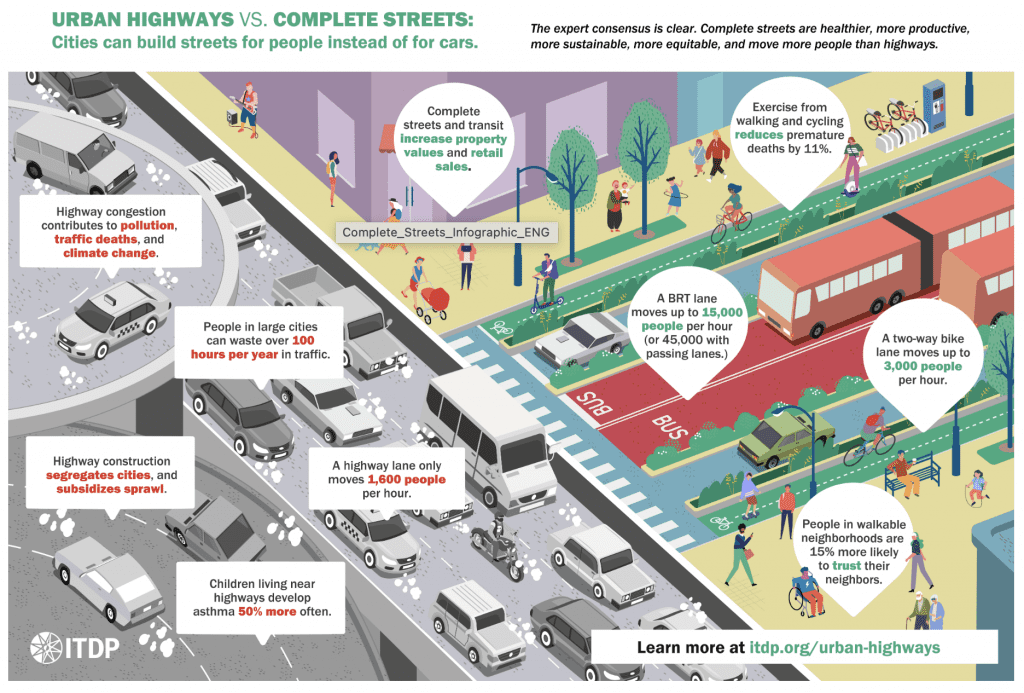By Jacob Teter Independent Consultant and D. Taylor Reich, Data Science Manager Institute for Transportation and Development Policy
Decreasing the number of miles traveled by cars and trucks is one of the most impactful measures considered in a recent International Council on Clean Transportation (ICCT) study of how road transport can limit carbon dioxide (CO2) emissions to align with a pathway that stays well below 2°C of global warming.
These reductions in vehicle activity can be achieved by reducing car dependence in cities and improving freight logistics. Here we’ll explore how deep these cuts in CO2 emissions could be and highlight some of the most promising policy options for cities seeking to realize these benefits. Ambitious zero-emission vehicle (ZEV) sales and avoid-and-shift measures together could avoid nearly 90 billion tonnes of cumulative road transport CO2 emissions globally by 2050, or about 60 percent of the total CO2 mitigation potential identified across all strategies in the ICCT’s analysis.
More than half of the CO2 emission cuts enabled through measures to avoid and shift car and truck activity come from reducing combustion engine car use in cities and shifting it toward alternative, zero-emission modes like walking, cycling, and electrified public transit. The other half of the cuts come from reducing the activity of trucks hauling freight.

In analyzing the regional and global CO2 mitigation potential of reducing car dependence in cities, the ICCT built on two previous assessments. One was a joint study by the ITDP and the University of California, Davis, The Compact City Scenario – Electrified report, and the other was conducted by the International Transport Forum (ITF), ITF Transport Outlook 2023. These reports and the ICCT’s study add to growing evidence that measures to reduce car dependence and shift toward more sustainable modes in cities can be a powerful tool for cutting CO2 and an important complement to accelerating vehicle electrification.
Establishing the potential for avoid-and-shift measures to reduce CO2 at a global level can raise the profile of such measures beyond the local level, thereby helping to build coalitions among cities and countries and encouraging their inclusion in national planning and policymaking. To do this, the ICCT study first grouped cities by region and population size, then ranked them according to the average annual travel by car of city residents (in car-passenger-kilometers per capita), from most to least car dependent. The study then modeled reductions in per-capita driving by assuming that each city emulates other less car-dependent cities with similar geographic, cultural, and political systems—without supposing that all cities exploit the full range of theoretically available tools of urban and transport planning, policy, design, and technology.
The ITDP and UC Davis study produced a larger estimate of the potential of mode shift. In the “The Compact City Scenario – Electrified,” cities are assumed to prioritize infill development until they reach a minimum population density of 4,000 inhabitants per square kilometer and then to ensure that any greenfield development has a population density of at least 16,000 inhabitants per square kilometer. In doing so, cities densify to a point where “transit, walking, and cycling can feasibly replace driving for most daily needs.” Under this approach, ITDP and UC Davis estimated that a roughly 50 percent reduction in car travel is possible by 2050 relative to current trends. By comparison, the ICCT study estimates a more conservative 37 percent reduction in car travel by 2050 compared to a business-as-usual scenario.
Getting anywhere within this range of global car travel reductions will require action across thousands of cities. Luckily, those cities can expect a wide range of benefits in return for this action. Reducing reliance on cars not only adds more air quality and climate benefits on top of the shift to electric mobility, but also provides a range of further benefits, including making cities more economically productive and resilient. Residents in cities with a diversity of mobility options spend less money and waste less time commuting. Cities with good public transport, walking, and cycling infrastructure have healthier, happier, and more socially engaged residents who enjoy more equitable access to city services and lower rates of road fatalities.
So, what actions can cities take to reap these benefits? Reallocating street space and transportation budgets away from roadway expansion and toward walking, cycling, and public transit is one of the best ways to start. From there, a mix of urban planning and policy, together with a redesign of street space and the rules that dictate how it is used, can help ensure that all residents have access to a wide range of safe and affordable mobility options.
Policies that support more compact development—including enabling the by-right development of multifamily housing and the promotion of affordable housing in all neighborhoods—are likely to offer better mobility opportunities. Such policies would allow future residents to meet their daily needs more easily and sustainably. Transport planners could also help by designing streetscapes for people instead of cars in order to realize the benefits outlined by designing more “complete streets.”

For example, it is possible to alter existing streets in many cities so that every resident lives on a street with sidewalks that are safe for people of any age, and within a 5-minute walk of a physically protected bicycle lane, a 10-minute walk of a bus line that comes every 10 minutes or less, and a 15-minute walk of rapid transit like metro or bus rapid transit (buses with dedicated, center-running lanes).
Finally, measures that consider the costs cars impose on others, such as zonal and hourly parking, can offer better balance, as often only drivers benefit from public investment in road infrastructure while cyclists and pedestrians bear the costs of reduced safety, restricted mobility, and elevated air pollution. A wide array of tools is available to policymakers in cities around the world, and many of these tools have the potential to provide net savings for public budgets and private citizen budgets.

